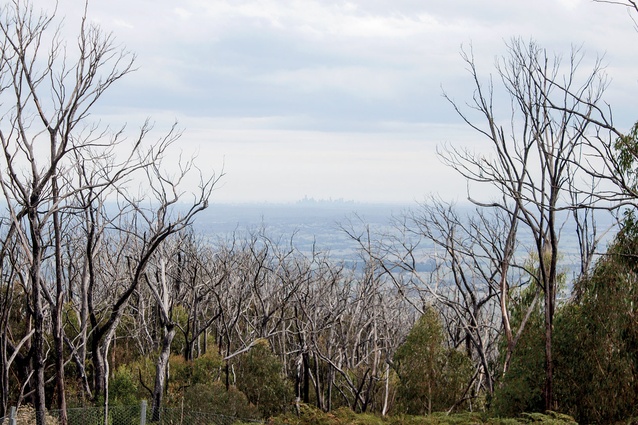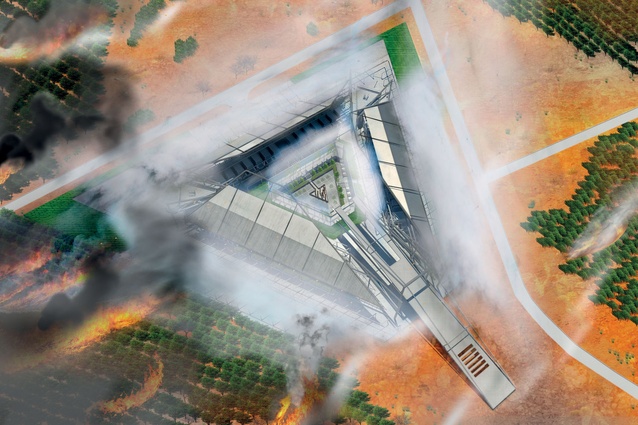In search of bushfire architecture
Bushfires have affected the lives of Australians for more than a century. With the beginning of a new year and a bounty of renewal comes the resurgence of the next bushfire season. Instigated by a combination of high temperatures, strong winds, low humidity and flammable vegetation, bushfires cause a growing and relentless calamity. Nationally, bushfires have been closely associated with Australian culture during the summer period, with television screens showcasing countless reports of firefighters trying to regulate unpredictable infernos.
The dry state of Victoria contains a quarter of Australia’s population and is the most densely populated state, making its inhabitants significantly more at risk from bushfire danger. This threat is also due to the diversity of vegetation typologies the state fosters, with some flora species more susceptible to catching alight, and the variety of topography profiles which means that bushfire travels faster up a steep slope than across a plateau, due to wind pressure and direction aiding its growth and movement.
Some of the worst recorded bushfires to take the state by storm are: the Grampians fire in 2006, which burnt the entire Grampians National Park; the Great Divide in 2007, where 70 individual fires united to become one great bushfire: and the Kilmore East bushfire of 2009, known colloquially as ‘Black Saturday’ and which was arguably the most devastating bushfire of all with 173 fatalities and 2,200 buildings destroyed. Since 2009, hotter, drier and windier conditions have occurred well before the predicted bushfire season, resulting in numerous outbreaks – in New South Wales, for instance – and have triggered anxiety and debate, once again. With the unquestionable exacerbation of climate change contributing to this forbidding context, it is not hard to comprehend that future firestorms like these will become more frequent, more intense and even deadlier.
Bushfires are a contemporary concern to be explored through architectural thinking and design. My master’s research at The University of Auckland has addressed the most devastating case study of all: ‘Black Saturday’. The big question I asked was, “How can the role of architecture, as the critical participant in the conditioning of public and private space, be capable of responding, adapting, performing and generating mitigation for the bushfire-prone community of Kinglake in Victoria?” This critical question led a research-and-design investigation into what exactly the bushfire phenomenon is and how the architectural community can respond effectively towards its threat. I undertook a methodical journey, visiting the site of the ‘Black Saturday’ bushfire and its aftermath, in order to start addressing this question and to learn more about the disaster and its habits firsthand.
On 15 April 2013, I caught the V/Line towards the devastation that broke out approximately 55km north of Melbourne Central. After an hour-long commute, I landed in Kilmore East where it was reported that the bushfire had begun on that fateful day, via a faulty electronic break at 12 noon. It soon became apparent – based upon previous research into the ‘Black Saturday’ bushfire and upon arrival at the site – that the Kilmore community west of Kilmore East Railway Station was not the centre of attention but, rather, it was Kinglake Central, which was in the heart of where the greatest physical damage to land, properties and lives occurred. The stark contrast between visiting Kilmore and visiting Kinglake was harrowing. Everywhere you turned, there were constant reminders of that dangerous period four years ago, with countless eucalyptus and pine plantations standing as dead weight in the environment.
Talking with locals about this touching subject was a testing-yet-rewarding experience, with one lady at a local café in Kinglake Central kindly directing us towards Mt Sugarloaf on National Park Road, an area that was completely taken over in the firestorm and classified as a high-bushfire-risk zone. Encountering the alpine summit part of the greater Kinglake National Park, I knew that I had found the site for implementing my architectural response. With a mesmerising view of the Melbourne metropolis in the distance, framed by a plethora of dead bush and labelled as a productive block in which rebuild efforts were securing and expanding the Kinglake community with numerous new constructions, it was soon evident that this was the perfect location to challenge and explore what could be envisioned and fabricated in this hazardous context.
To conceive a proposal that could be defined as ‘bushfire architecture’, it was necessary to gain a greater understanding of bushfire phenomena from a variety of consultants, each with individual expertise on the situation.
I interviewed Ken Watson from NASH (National Association of Steel Framed Housing) in Melbourne, who is part of a steel construction company, which instinctively considered what its product could provide after ‘Black Saturday’ and whether there was an economical solution. This influenced a full-scale prototype test – which began, essentially, with a normal steel-framed home with steel trusses and steel cladding – conducted in Mogo, south of Sydney, on a rural fire services facility. “The house survived!” Ken stated blissfully after the steel-framed test house had withstood more than an hour of exposure to man-made bushfire temperatures. The test revealed windows as a major challenge because large shutters were required, thus limiting the size of glass allowed, which is not desirable to home-owners who want to enjoy their views of the Australian bush. In terms of other materiality, the application of timber for external treatments was not supported by Ken, since it would require expensive solutions for it to become fire retardant.
Charles Clifton, a fire engineer from The University of Auckland, was also an advocate for steel-based construction, underlining the point that steel works differently in a system rather than as individual components – shedding the load from ‘heavy bits’ towards ‘lighter bits’ to maintain the building’s structural integrity. Another point made was about securing boundaries between properties and bush of up to 100m, similar to the designs for schools and playing fields, which have been proven to provide great refuge during the bushfire season. Also, the encouragement of a non-combustible envelope like steel or concrete does not add any fuel to the fire itself, unlike timber, with the roofscape and underfloor space being high-potential attack zones.
Fire specialist Greg Baker from BRANZ touched upon the kinds of test conducted in order to receive suitability for construction for fire, with flammability and combustibility being the two key characteristics tested. In order to meet the exposure of 900 degrees celsius from a fire, when designing and building, he recommended consideration of the materials being used, the structural design itself and other systematic measures to be employed, such as sprinklers.
To help me grasp an experiential understanding of what real bushfire is like, Scott Marchant from the rural fire department in Silverdale, Auckland, revealed that topography, wind speed, wind direction, humidity and fuel load (the type of vegetation being burnt) are influencing factors in bushfire severity. The best method of approach, Scott suggested, is including firebreaks which do not put out a bushfire but, rather, limit the propagation of its threat.
After receiving these numerous findings from the fire and bushfire experts, it was clear that responding to this complex danger with a viable architectural solution was going to be demanding and detailed.
When providing shelter for people in bushfire-prone areas, the central cause of concern is the building envelope. This is due to the external treatment being under attack by three types of bushfire spread: fire spreading by flying embers and burning debris, fire spreading by heat radiation and fire spreading by direct flame contact. Adaptive building design counteracts the likelihood of properties being exposed to these three ‘burning typologies’ by considering: the building’s shape; its roof design; floors and underfloor spaces; whether there are verandahs or decks attached to the property; what sort of structure the walls are made from; how doors, windows and vents are protected; and whether services are supplied through alternative means.
Adaptive landscaping design is also a fundamental part of this equation, where land formation design and location of particular plantations can alleviate the threat of an encroaching bushfire attack. The problem with existing architecture is that it has not adapted appropriately in regard to both building and landscaping; homes that I saw during the visit to Kilmore and Kinglake were being built still with timber construction and with landscape margins not being clearly demarcated in the ground. This revelation called not only for concern but for ideas that are worthy of implementing – to protect these properties and this land from future bushfire attacks.
Ideas that are successful in tackling this issue – both in Australia and here in New Zealand on Great Barrier Island – can be reflected through my final design solution, titled the Resilient Bushfire Community. From adversity, this bushfire architecture responds, adapts, performs and generates mitigation against bushfire activity through a reactive, constantly in flux, autonomous roofscape, and the protective cocoon-layered arrangement that it expresses. The roofscape works as a weather-measuring, steel-framed, mechanical system, consisting of three wings, each of which changes its angle of incline, based upon the readings received from barometers, which measure the atmospheric surroundings. In use, the roofs are multi-purpose: effective in protecting against flying embers and strong winds during a bushfire attack, and useful in retrieving water during heavy rainfall periods outside bushfire season. In terms of the layered conception, they create a series of barriers which are structured in a manner that is best tailored towards controlling and slowing down the bushfire. For instance, the outermost layers are agricultural, with grassy paddocks and paving, which do not add much to fuel a fire. Firebreaks like these, encompassing the inner communities, provide effective shields towards the threat of bushfire, becoming sacrificial in the path towards safety.
A further development that can be implemented to fight against the problem of bushfire is an effective water source, which can be tapped into to improve the wet perimeters (irrigation lines) built into the layered framework. Water is drawn from the roofs and underground bore waterholes, and becomes stored in onsite tanks that are built beneath the earth’s surface. This method can be utilised for a variety of facilities, with the irrigation system being the most important of all. While the roofscape is reacting towards the changes in surroundings, so is the pressure of the water released from the irrigation jets that draw upon the underground water, creating a misty effect that directly cools the environment. This is constantly changing as the roof does, in relation to the season and the daily weather.
Other protective measures integrated into the design are fire watchtowers, an underground evacuation centre and non-combustible materials, such as steel, concrete, slate, rock and rammed earth. In conjunction with offering responsive solutions to bushfire danger, the proposal also provides a sense of hope, security and life, with numerous commercial and domestic facilities catered for in architectural villages, which celebrate the region and exemplify the traditional local Kinglake markets, ensuring they become symbols of endurance in the most testing of times.
With Cedric Price’s architectural approach in mind, it is my hope that the profession starts to become a problem-solving practice. This study’s intention is to transform weather into a communicative resource, rather than an incessant problem that architects are contending with daily in practice. Architecture, in this respect, becomes more active and social through bold technological and mechanical exposure, deviating away from conventional static formalism that exists vividly among us. Bushfires and Australia’s endless climatic unpredictability become visually marked in time – recording, responding, adapting and contracting according to the changes in the daily weather and climatic surroundings. Bushfire becomes an instigator, an architectural catalyst and an animator – alarming the communities of an approaching fire front and the warmer season, creating what can be defined here as responsive bushfire architecture. It is only a matter of time before the next natural bushfire disaster is upon us, making premeditated preparation and design essential for future survival.











